CEP – KAS: Sahel Monitoring March 2024

Since the record high of 129 claims per month in January 2024, the number of claims and statements has dropped, slightly. In March, a combined 95 claims were published by Jama’a Nusrat ul-Islam wa al-Muslimin’ (JNIM) and both Islamic State branches active in the Sahel. Nonetheless, the trend points toward a likely increase again in the months to come.
Overall, it seems highly unlikely that the terrorist surge of the past year in the Sahel will be slowing down. As American military forces are being forced out of Niger, the site of one of their most important airbases in northern Africa, it is unclear how the new government will fight the Jihadi-terrorist insurgency within the country or in the wider region. On March 16, a spokesman of the military junta in Niger denounced the military agreement with the USA after accusing it of “illegal activity in the country and false accusations of a uranium deal with Iran”.
(Source https://x.com/SimNasr/status/1769105845923504551)
The negative security trajectory in the region, accelerated with multiple military coups in the past few years, continues. Western forces were asked to leave by the new-ruling military regimes in Mali, Burkina Faso, and Niger and are being gradually replaced by Russia’s Africa Corps (the former Wagner Group). Rather than a replacement for counter-terrorism operations, the combination of local security forces and Russian mercenaries are regularly involved in random attacks and massacres of the local population, under the pretext of controlling Jihadi-terrorist uprisings. This will very likely further radicalize parts of the local population and make them susceptible to terrorist recruitment.
These attacks on local populations are also exploited by terrorist propaganda. For example, on March 2, such an attack by government forces against the local population was published by az-Zallaqa Media under the title “the attacks targeting innocents continue”. In total, eight civilians were killed by the Malian Army and the Wagner Group / Africa Corps.
Claims like these have been confirmed by independent research done by Human Rights Watch (HRW). On March 28, HRW published an article on its website entitled Mali: Army, Wagner Group Atrocities Against Civilians - Investigations Needed Into Indiscriminate Drone Strikes, Summary Killings. Nearly all previous claims by JNIM concerning attacks by local military forces on the civilian population were also confirmed by HRW.

Image 1: az-Zallaqa Media: targeting innocent people continues.
Attacks in the Sahel – General Trend
For the second consecutive month, the claims by JNIM outnumbered by far those of both Islamic State branches. JNIM claimed no fewer than 50 incidents, whereas Islamic State’s Western Africa Province (ISWAP) claimed only 27 attacks, the lowest number since October 2023. Remarkable was the level of output by Islamic State in the Greater Sahel (ISGS); no fewer than 18 claims were published via the Islamic State’s media channels. This is the highest number of incidents claimed by ISGS since reporting started in December 2022.
In general, the situation continues to deteriorate month by month. Not only are the Jihadist-terrorist groups continuously targeting the militaries of the entire region; more and more, they are engaging in open confrontation. Both JNIM and ISGS are battling for control over (parts of) Mali, Burkina Faso and Niger, and on several occasions this competition has led to incidents of terrorist infighting. On four occasions, the Islamic State claimed attacks targeting JNIM. In the most significant of these incidents, claimed in an-Naba’ March 15, ISGS said it killed 16 al-Qaeda fighters and captured four others. All were interrogated and later executed. Among the victims was JNIM’s leader of the Intilit region, Ilias Amadou Mousa; pictures of his execution were published by the Islamic State’s media branches.

Image 2: Mali – ISGS claims the execution of JNIM leader Ilias Amadou Mousa
Table 1: Claimed Attacks (December 2022 – March 2024)

Table 2: Claimed Attacks per Group (December 2022 – March 2024)
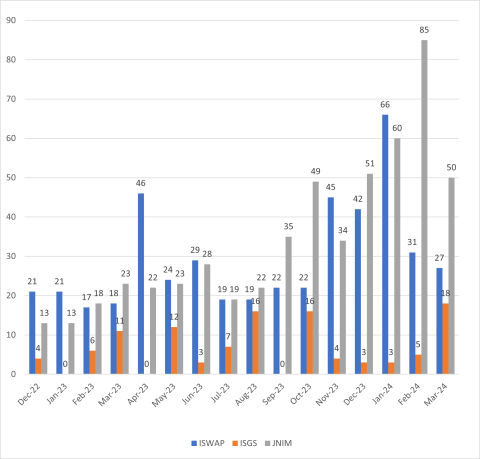
Table 3: Claimed Attacks per Country (December 2022 – March 2024)
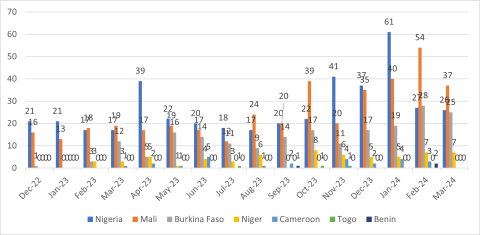
Attacks per Country
- Mali
Mali suffered the brunt of the attacks again; no fewer than 37 incidents were claimed, 12 by ISGS, resulting in at least 75 casualties. In these attacks, ISGS targeted fighters of JNIM, the Malian army, the Wagner group and the Christian population. By far, the clashes with JNIM were the most impactful, as the local branch leader of JNIM, Ilias Amadou Moussa, was captured and killed.
25 claims were published by az-Zallaqa media; five of these dealt with crimes against the civilian population resulting – according to the terrorist propaganda outlet – in the death of a significant number of civilians, killed by the Malian army and Russian mercenaries.

Image 3: the remains of a Malian Army vehicle after an IED attack by JNIM
- Nigeria
Nigeria witnessed a total of 26 registered attacks. According to the claims, these attacks were primarily aimed at military forces, resulting in approximately 100 casualties. One of the victims was a member of the Election Commission who was killed by Islamic State militants during an attack on his house in Jakana, Borno province.
- Burkina Faso
Burkina Faso was hit 25 times this month, on two occasions by ISGS; all other claims were published by JNIM. These attacks resulted in approximately 100 casualties. The attacks were primarily directed against the the army and loyalist militia.
ISGS did claim one attack however on Christians in Essakane; 15 people were killed. An important detail is that there is a gold mine of IAMGOLD Corporation in Essakane. As the mining company states on its website: “Sustaining capital expenditures for 2024 are expected to be approximately $215 million (± 5%) of which the majority is related to capitalized stripping at Essakane and underground development at Westwood, with an additional $5 million (± 5%) in expansion capital expected at Essakane.” The ownership of Essakane is 90 percent IAMGOLD and 10 percent Burkina Faso; an annual income of roughly 21,5M $ for the country. Although there is currently no proven link between the attack on the Christian population and the gold mine, it is noteworthy that ISGS struck close to a significant source of income for Burkina Faso (see picture below).
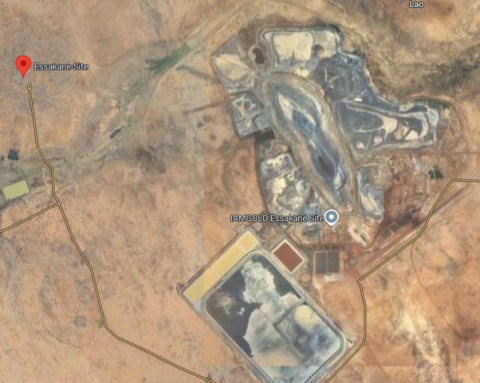
Image 4: Essakana and the gold mine (GoogleMaps)
- Niger
In Niger, seven attacks were claimed, the majority by ISGS (four), followed by JNIM with two and ISWAP with one claimed incident. The attacks resulted in at least 50 casualties, mostly Nigerien soldiers.
Table 4: Total number of attacks
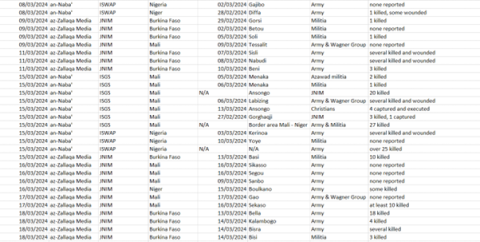
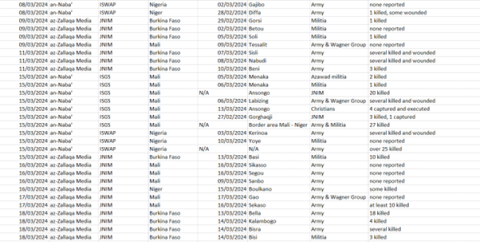


Claims per Affiliate
JNIM
Az-Zallaqa Media published a total of 50 statements in March. In five of these, JNIM decries the continuous attacks by the Malian Army and the Russian Wagner Group / Africa Corps against the local population. All other claims, 45 statements, concern attacks on various military and militia targets. At least 13 improvised explosive devices (IEDs) were used in these attacks. The claims state that each one of these attacks resulted in the “killing or wounding everyone on board”. The exact number of casualties was never reported. JNIM claimed 25 events in Mali, 23 in Burkina Faso, and 2 in Niger.

Image 5: Operations of JNIM during the month of Shaban, 1445 AH – February 11 – March 11 2024
Table 5: Claims by JNIM
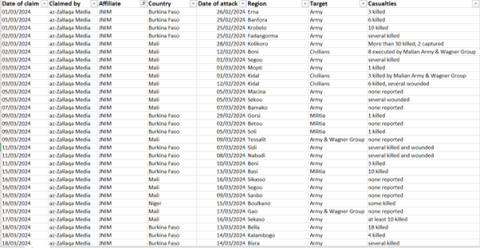

ISWAP
The Islamic State’s Western Africa Province claimed 26 attacks in Nigeria, and one in Niger. On eight occasions, IED’s were used. Two of these were suicide vehicle borne improvised explosive devices (SVBIED) attacks resulting in at least 20 casualties. Both SVBIED attacks were likely conducted by locals. Their kunya (war name) included the suffix al-Ansari (the helper), a title given to local members of the Islamic State.
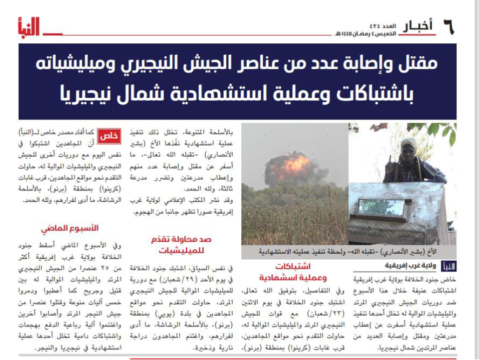
Image 6: Screenshot of one of the claimed SVBIED-attacks from an-Naba’ 434 (March 15, 2024)
Table 6: Attacks by ISWAP
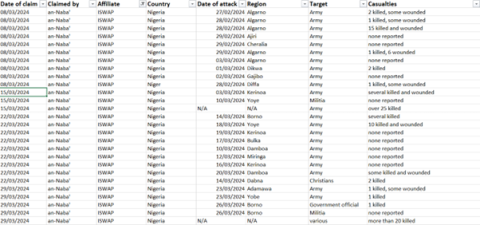
ISGS
A total of 18 incidents were claimed by ISGS, the highest number since reporting started. It is noteworthy that even though March had the highest number of claims by ISGS, some of these claims refer to attacks that date back to January 2024.
Attacks were claimed in Mali (12), Niger (4) and Burkina Faso (2). The operations conducted in Mali, targeted the variety of Islamic State enemies: Christians, the Malian Army, Russian mercenaries, and above all, JNIM. At least 24 JNIM fighters were killed in three different claimed incidents,, one dating back to January 15. On March 15, the Islamic State published an extensive description of its most recent confrontation with JNIM, which resulted in the killing of at least 20 al-Qaeda fighters, including JNIM’s local leader, Ilias Amadou Moussa.

Image 6: The execution of JNIM leader Ilias Amadou Moussa
Table 7: Attacks by ISGS

Conclusion
March 2024 was yet another month in which pervasive Jihadi-terrorist violence became “business as usual” in the Sahel region. Since reporting began, not only has the number of attacks increased dramatically, but the affected areas have continued to grow. What once were the Islamic State and al-Qaeda local strongholds have now developed into much larger, quasi-permanent areas of control. Meanwhile, the threat that this terrorist violence presents to neighboring countries continues to increase. Jihadi-terrorist operations by al-Qaeda and the Islamic State were never meant to be local, they are part of the global plan of action of both terrorist networks. Unfortunately, it is very likely only a matter of time before this terrorist violence spills over into more countries in the region. The development of terrorist violence in Niger in the past few months is an ominous warning to the rest of the region. Growing terrorist influence combined with increasing political instability in the region and the expanding operations of Russian mercenaries have boosted instability and provided ever more opportunities for both al-Qaeda and the Islamic State not only to consolidate their positions, but continue to grow.
Stay up to date on our latest news.
Get the latest news on extremism and counter-extremism delivered to your inbox.